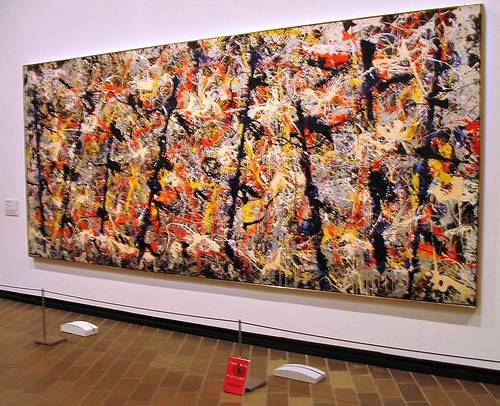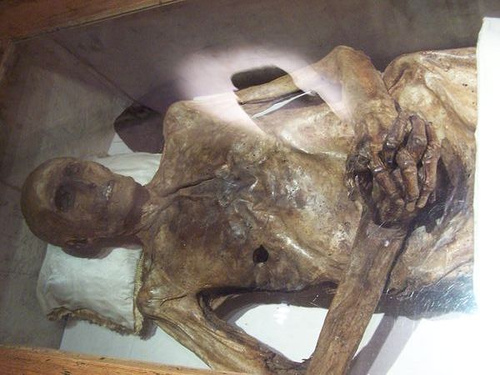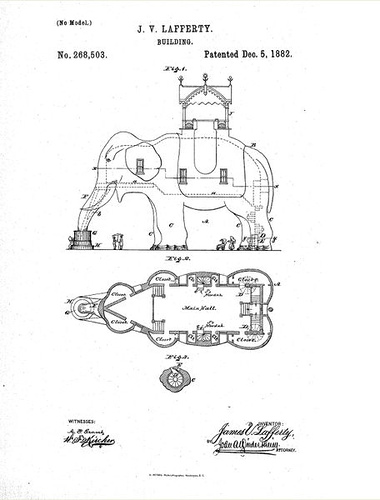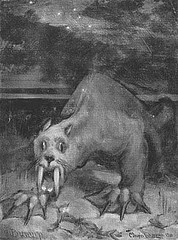
Artist Jackson Pollock put his canvas on the floor and poured paint on it from a height.
Critics called him “Jack the Dripper.”

Artist Jackson Pollock put his canvas on the floor and poured paint on it from a height.
Critics called him “Jack the Dripper.”
The Bavarian village of Oberammergau has a special deal with God. While the bubonic plague was ravaging Europe, the town’s citizens vowed that if they were spared they would perform a play every 10 years depicting the life and death of Jesus.
God, apparently, accepted. The death rate among adults rose from 1 in October 1632 to 20 in March 1633, but then it dropped again to 1 in July 1633.
True to their word, the villagers staged a play in 1634, and they’ve done so every 10 years ever since.
Excerpts from student exams in the 19th century:
— From Mark Twain, “English as She Is Taught: Being Genuine Answers to Examination Questions in Our Public Schools,” 1887

Christian Friedrich von Kahlbutz is looking remarkably fit for his age. The Prussian knight died in 1702 and his body hasn’t decayed.
No one knows why. He wasn’t embalmed. A legend says it’s God’s punishment for an oath he broke while living. Scientists think he lost a lot of blood before dying and that the local soil lacked materials that would promote decay. But that doesn’t explain why other bodies nearby did rot.
A Latin palindrome:
IN GIRUM IMUS NOCTE ET CONSUMIMUR IGNI.
(“We enter the circle at night and are consumed by fire.”)
It was said to describe the behavior of moths.
The first Humvee manufactured for civilian use was bought by Arnold Schwarzenegger.

The largest elephant in the world is made of wood and tin sheeting. “Lucy” was built south of Atlantic City in 1882 by James V. Lafferty, who hoped to attract tourists and sell real estate.
Lafferty saw big potential in “zoomorphic architecture,” apparently. He got an exclusive patent on animal-shaped buildings, and soon surpassed Lucy with an Elephantine Colossus at Coney Island. At 12 stories tall, it was twice Lucy’s size, with a cigar store in one leg, a dioramic display in another, hotel rooms in the body, and an observation area at the top, with panoramic views of the sea.
Sadly, the Elephantine Colossus was destroyed by fire in 1896, but Lucy herself still stands, and has served as a restaurant, a business office, a cottage, a hotel, and a tavern. Today she’s a national historic landmark.
“There is nothing so absurd but some philosopher has said it.” — Cicero

If you visit Australia, beware the bunyip, a bizarre creature with a horse’s tail, flippers, and walrus tusks. Bloodcurdling cries can be heard at night as it devours its prey, and it’s particularly fond of human women.
Does it really exist? Who knows? Australia’s real fauna is so strange that European settlers couldn’t tell the difference. In 1846 a peculiar skull was found on the banks of the Murrumbidgee River in New South Wales, and the Sydney Morning Herald reported that “almost everyone became immediately aware that he had heard ‘strange sounds’ from the lagoons at night, or had seen ‘something black’ in the water.” In the district of Greta, Victoria, residents heard a loud booming sound coming from the local swamp, but search parties found nothing. They finally drained the swamp, and the sound ceased.
Okay, maybe there’s no bunyip, but that’s the not the end of your worries. Australians also warn of the drop bear, a sort of plunging koala; the hoop snake, which rolls like a wheel after its prey; and the yowie, which is either an ant/lizard or a giant ape. Pack a flashlight.
In the winter of 1803, Japanese fishermen discovered a strange vessel at Harayadori, northeast of Tokyo. They said it resembled a pot for cooking rice, 3.5 meters high and 5.5 meters in diameter, with a wide brim. The top was covered with pitch and contained glass panels and a sliding door; the bottom was made of bands of the “finest foreign iron.”
Inside they found a woman. “She seemed to be 20 years old, … had a fair complexion like snow and wore her excellent black hair dangling behind her back. Her beauty was beyond description.” She could not communicate with the fishermen and appeared to guard “a small box and let no one come near it, for reasons unknown.”
This account is recorded in two different texts, Dust of Japanese Apricots and Anecdotes from the Rabbit Garden, both containing contemporary illustrations. Unfortunately, neither tells what became of the woman or her vessel.